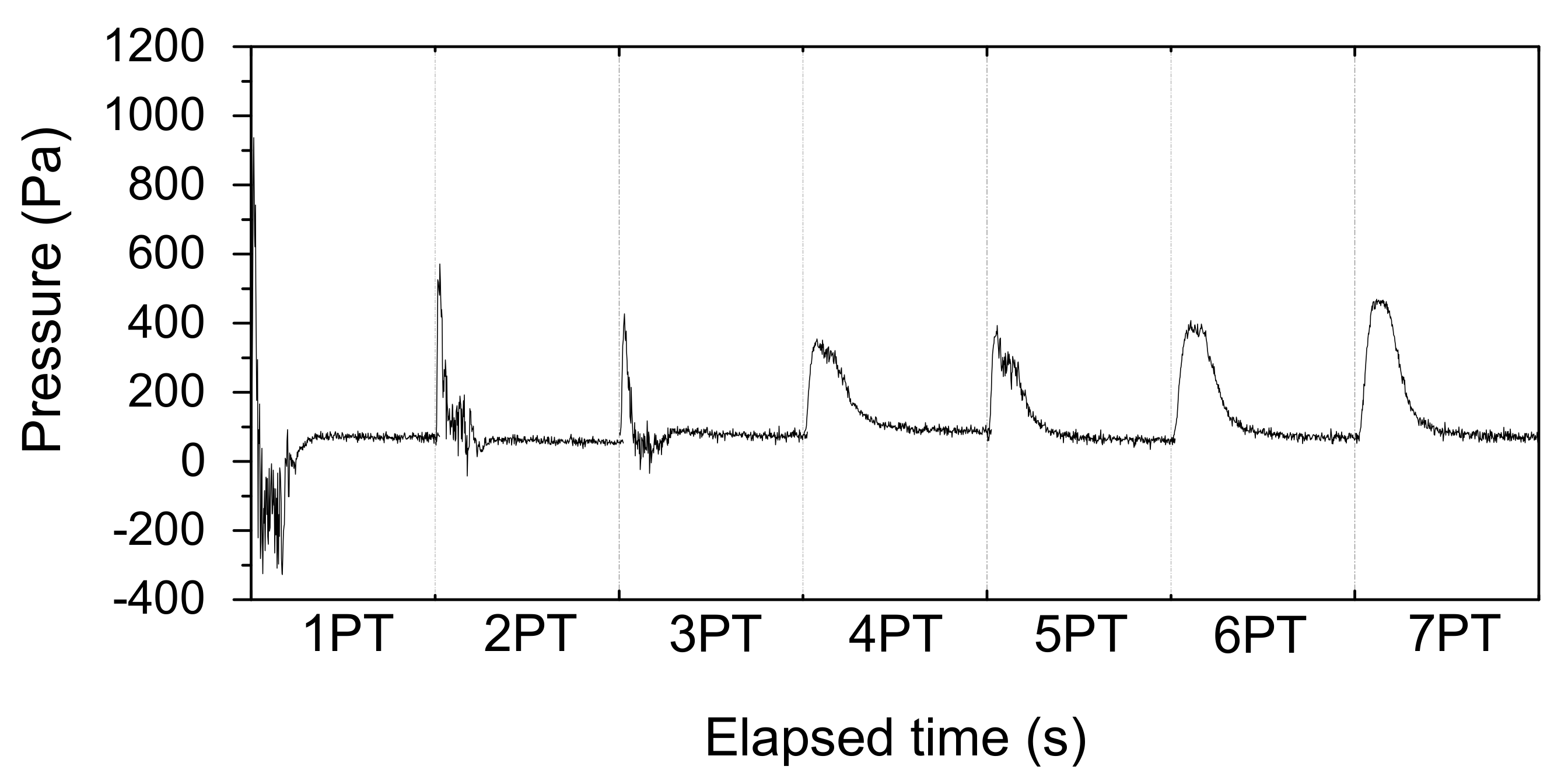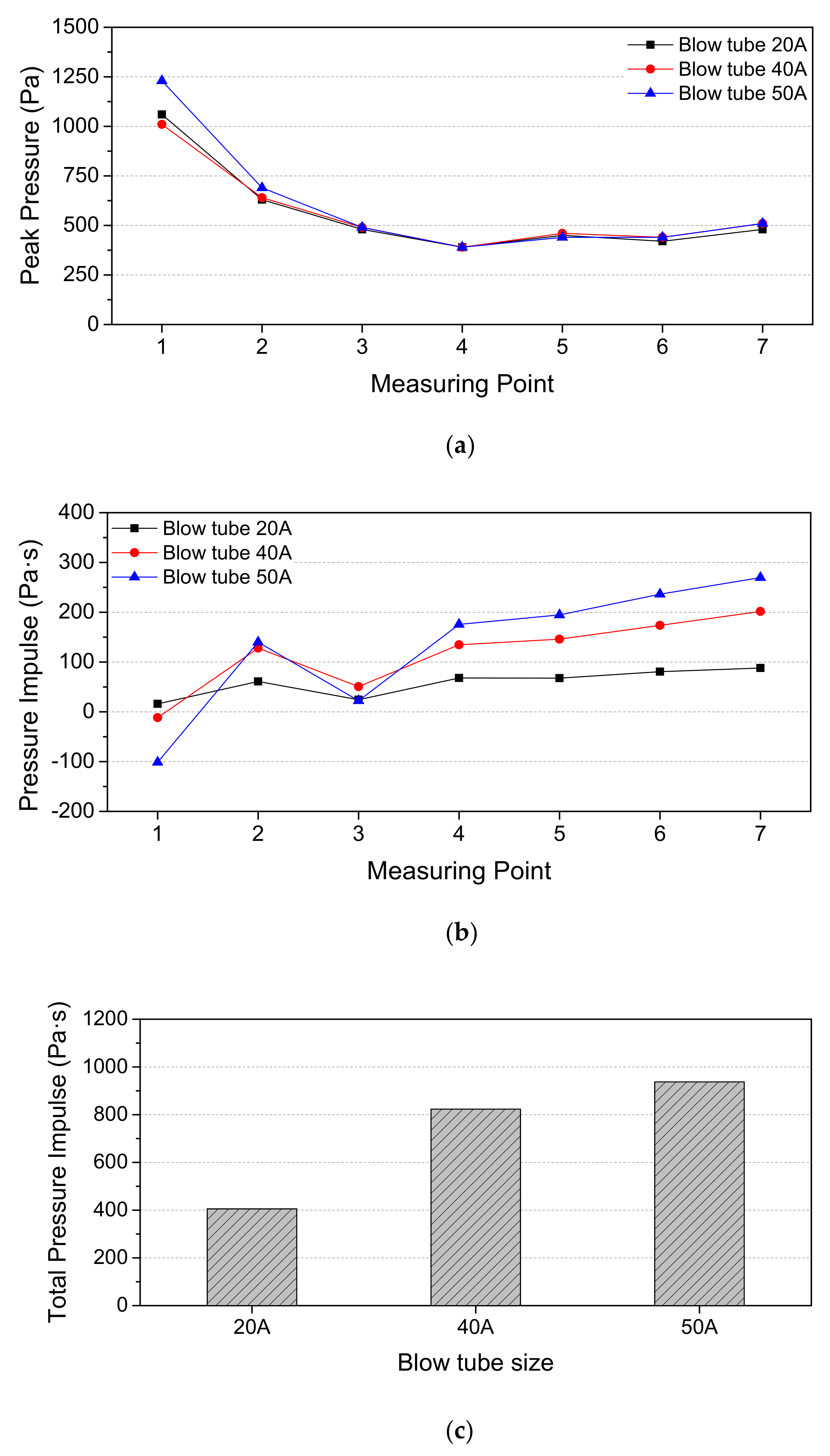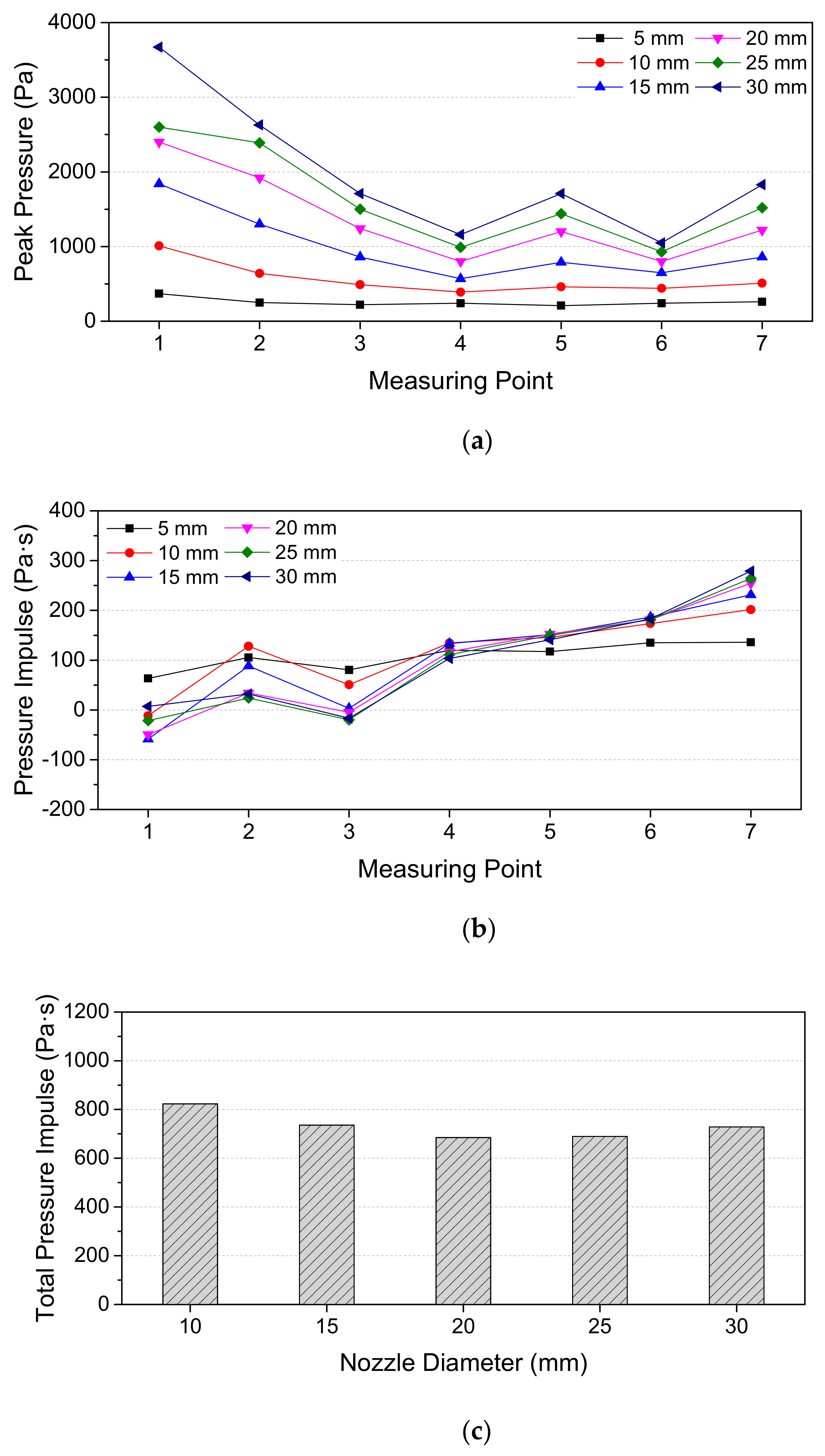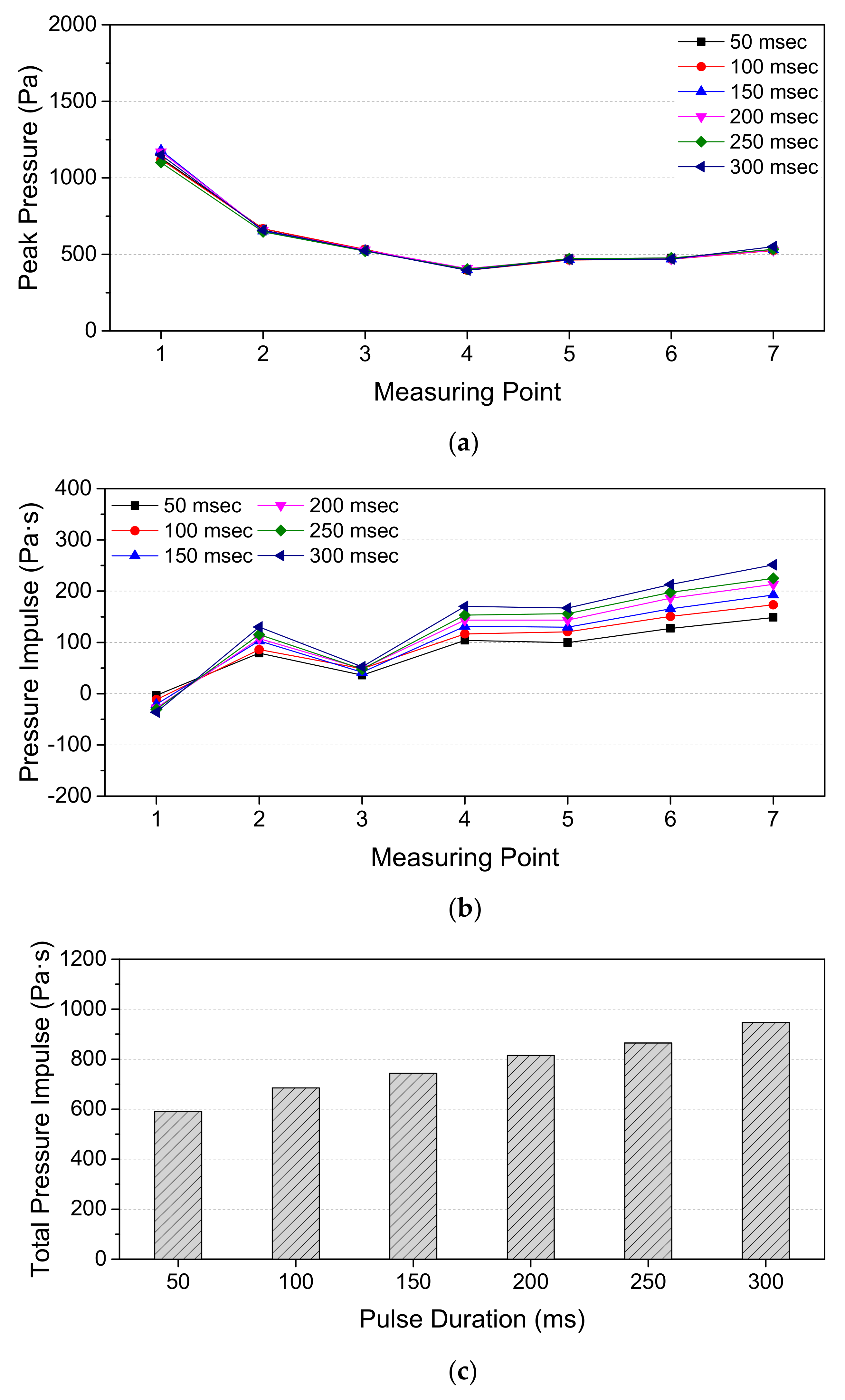Experimental Study on the Operating Parameters of a Pulse-Jet Filter Bag Cleaning System
Abstract
:1. Introduction
2. Materials and Methods
2.1. Experimental Setup
2.2. Characterization of the Filter Bag Cleaning Performance
3. Results and Discussion
3.1. Influence of Blow Tube Size on the Filter Bag Cleaning Performance
3.2. Influence of Nozzle Diameter on the Filter Bag Cleaning Performance
3.3. Influence of Initial Tank Pressure and Pulse Duration Time on the Filter Bag Cleaning Performance
4. Conclusions
Author Contributions
Funding
Data Availability Statement
Acknowledgments
Conflicts of Interest
References
- Jeon, K.J.; Jung, Y.W. A simulation study on the compression behavior of dust cakes. Powder Technol. 2001, 141, 1–11. [Google Scholar] [CrossRef]
- Saleem, M.; Krammer, G. Effect of filtration velocity and dust concentration on cake formation and filter operation in a pilot scale jet pulsed bag filter. J. Hazard. Mater. 2006, 144, 677–681. [Google Scholar] [CrossRef] [PubMed]
- Klingel, R.; Löffler, F. Influence of cleaning intensity on pressure drop and residual dust areal density in a pulse-jet fabric filter. In Proceedings of the Filtech Conference, London, UK, 15 September 1983; pp. 306–314. [Google Scholar]
- Sievert, J.; Löffler, F. Fabric cleaning in pulse-jet filters. Chem. Eng. Process. 1989, 26, 179–183. [Google Scholar] [CrossRef]
- Lu, H.C.; Tsai, C.J. Numerical and experimental study of cleaning process of a pulse-jet fabric filtration system. Environ. Sci. Techynol. 1996, 30, 3243–3249. [Google Scholar] [CrossRef]
- Simon, X.; Chazelet, S.; Thomas, D.; Bémer, D.; Régnier, R. Experimental study of pulse-jet cleaning of bag filters supported by rigid rings. Powder Technol. 2007, 172, 67–81. [Google Scholar] [CrossRef]
- Andersen, B.O.; Nielsen, N.F.; Walther, J.H. Numerical and experimental study of pulse-jet cleaning in fabric filters. Powder Technol. 2016, 291, 284–298. [Google Scholar] [CrossRef] [Green Version]
- Qian, Y.; Bi, Y.; Zhang, Q.; Chen, H. The optimized relationship between jet distance and nozzle diameter of a pulse-jet cartridge filter. Powder Technol. 2014, 266, 191–195. [Google Scholar] [CrossRef]
- Shim, J.; Joe, Y.H.; Park, H.S. Influence of air injection nozzles on filter cleaning performance of pulse-jet bag filter. Powder Technol. 2017, 322, 250–257. [Google Scholar] [CrossRef]
- Qian, Y.; Chen, H.; Dai, H.; Liu, T.; Kuang, T.; Bian, L. Experimental study of the nozzle settings on blow tube in a pulse-jet cartridge filter. Sep. Purif. Technol. 2018, 191, 244–249. [Google Scholar] [CrossRef]
- Lu, H.C.; Tsai, C.J. Influence of design and operation parameters on bag-cleaning performance of pulse-jet baghouse. J. Environ. Eng. 1999, 125, 583–591. [Google Scholar] [CrossRef]
- Tsai, C.J.; Tsai, M.L.; Lu, H.C. Effect of filtration velocity and filtration pressure drop on the bag cleaning performance of a pulse-jet baghourse. Sep. Sci. Technol. 2000, 35, 211–226. [Google Scholar] [CrossRef]
- Lu, H.C.; Tsai, C.J. Influence of different cleaning conditions on cleaning performance of pilot-scale pulse-jet baghouse. J. Environ. Eng. 2003, 129, 811–818. [Google Scholar] [CrossRef] [Green Version]
- Yan, C.; Liu, G.; Chen, H. Effect of induced airflow on the surface static pressure of pleated fabric filter cartridges during pulse jet cleaning. Powder Technol. 2013, 249, 424–430. [Google Scholar] [CrossRef]
- Qian, Y.; Bi, Y.; Zhang, M.; Chen, H.; Xu, G. Effect of filtration operation and surface treatment on pulse-jet cleaning performance of filter bags. Powder Technol. 2015, 277, 82–88. [Google Scholar] [CrossRef]
- Liu, X.; Shen, H. Effect of venturi structures on the cleaning performance of a pulse jet baghouse. Appl. Sci. 2019, 9, 3687. [Google Scholar] [CrossRef] [Green Version]
- Furumoto, K.; Narita, T.; Fukasawa, T.; Ishigami, T.; Kuo, H.P.; Huang, A.N.; Fukui, K. Influence of pulse-jet cleaning interval on performance of compact dust collector with pleated filter. Sep. Purif. Technol. 2021, 279, 119688. [Google Scholar] [CrossRef]
- Li, Q.; Zhang, M.; Qian, Y.; Gne, F.; Song, J.; Chen, H. The relationship between peak pressure and residual dust of a pulse-jet cartridge filter. Powder Technol. 2015, 283, 302–307. [Google Scholar] [CrossRef]
- Lo, L.M.; Hu, S.C.; Chen, D.R.; Pui, D.Y.H. Numerical study of pleated fabric cartridges during pulse-jet cleaning. Powder Technol. 2010, 198, 75–81. [Google Scholar] [CrossRef]






| Test No. | Blow Tube | Nozzle Type | Nozzle Diameter (mm) | Pulse Air Pressure (MPa) | Pulse Distance (mm) | Pulse Duration (ms) |
|---|---|---|---|---|---|---|
| 1 | 20A, 40A, 50A | Nipple | 10 | 0.4 | 130 | 100 |
| 2 | 40A | Nipple | 5, 10, 15, 20, 25, 30 | 0.4 | 130 | 100 |
| 3 | 40A | Nipple | 10 | 0.3, 0.4, 0.5, 0.6, 0.7 | 130 | 100 |
| 4 | 40A | Nipple | 10 | 0.4 | 130 | 50, 100, 150, 200, 250, 300 |
| Blow Tube Size | Outer Diameter (mm) | Thickness (mm) |
|---|---|---|
| 20A | 27.2 | 2.1 |
| 40A | 48.6 | 2.8 |
| 50A | 60.5 | 2.8 |
Publisher’s Note: MDPI stays neutral with regard to jurisdictional claims in published maps and institutional affiliations. |
© 2022 by the authors. Licensee MDPI, Basel, Switzerland. This article is an open access article distributed under the terms and conditions of the Creative Commons Attribution (CC BY) license (https://creativecommons.org/licenses/by/4.0/).
Share and Cite
Kim, E.; Byun, Y.; Bak, H.-S.; Koh, D.-J. Experimental Study on the Operating Parameters of a Pulse-Jet Filter Bag Cleaning System. Sustainability 2022, 14, 7276. https://doi.org/10.3390/su14127276
Kim E, Byun Y, Bak H-S, Koh D-J. Experimental Study on the Operating Parameters of a Pulse-Jet Filter Bag Cleaning System. Sustainability. 2022; 14(12):7276. https://doi.org/10.3390/su14127276
Chicago/Turabian StyleKim, Eunae, Youngchul Byun, Hyun-Su Bak, and Dong-Jun Koh. 2022. "Experimental Study on the Operating Parameters of a Pulse-Jet Filter Bag Cleaning System" Sustainability 14, no. 12: 7276. https://doi.org/10.3390/su14127276
APA StyleKim, E., Byun, Y., Bak, H.-S., & Koh, D.-J. (2022). Experimental Study on the Operating Parameters of a Pulse-Jet Filter Bag Cleaning System. Sustainability, 14(12), 7276. https://doi.org/10.3390/su14127276






